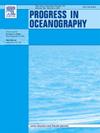阿留申海沟及其邻近地区足桡足动物的元条形码调查
IF 3.6
3区 地球科学
Q1 OCEANOGRAPHY
引用次数: 0
摘要
深海沟仍然是探索最少的海洋环境之一,它们的动物多样性仍然未知。海沟是否作为底栖生物的扩散屏障,可能导致它们内部和周围不同的动物群落,目前仍存在争议。本研究旨在利用多基因元条形码方法研究阿留申海沟及其周围的小型动物多样性。采用CO1和18S两种遗传标记来评估深海、深海和深海生境的潜在独特性。为了提高分类学鉴定的准确性,建立了一个精心策划的羽状螨类参考文库。所有取样点均显示出独特的小区系群落;然而,这两个标记都一致地检测到深海和深海组合之间的明显分离。与18S相比,CO1数据集中某些分类群的代表性不足(可能是由于引物偏倚),但群落结构的总体格局保持一致。除深度外,Chl-a(代表CO1)和TOC(代表18S)是影响微型动物群落组成的关键环境因子。值得注意的是,在横跨海沟的地点检测到8个COI otu,其中5个也在Clarion-Clipperton区检测到,这表明海沟并不一定是一个严格的扩散屏障。其中一个otu被分配给Dorsiceratus属,这是一个在以前的深海调查中很少遇到的分类群,这表明了元条形码的潜力,特别是当与精选参考图书馆结合使用时,可以揭示隐藏的生物多样性。本文章由计算机程序翻译,如有差异,请以英文原文为准。
Hadal copepods in and around: A metabarcoding Survey of meiofauna in the Aleutian trench and adjacent regions
Hadal trenches remain among the least explored marine environments, with much of their faunal diversity still unknown. It is still debated whether trenches act as dispersal barrier for benthic organisms potentially leading to distinct faunal communities within and around them. This study aimed to investigate the meiofauna diversity in and around the Aleutian trench using a multi-gene metabarcoding approach. Two genetic markers, CO1 and 18S, were used to assess the potential uniqueness of hadal, abyssal and bathyal habitats. To improve the accuracy of taxonomic assignments, a curated reference library of harpacticoid species was created. All sampling sites revealed unique meiofaunal communities; however, both markers consistently detected a clear separation between hadal and abyssal assemblages. While certain taxa were underrepresented in the CO1 dataset compared to 18S, likely due to primer bias, the overall patterns in community structure remained consistent. Besides depth, Chl-a (for CO1) and TOC (for 18S) emerged as key environmental factors influencing meiofauna community composition. Notably, eight COI OTUs were detected across sites spanning the trench, five of which were also detected in the Clarion-Clipperton Zone, suggesting that the trench does not necessarily act as a strict barrier to dispersal. One of these OTUs was assigned to genus Dorsiceratus − a taxon rarely encountered in previous deep-sea surveys − demonstrating the potential of metabarcoding, especially when combined with curated reference libraries, to reveal hidden biodiversity.
求助全文
通过发布文献求助,成功后即可免费获取论文全文。
去求助
来源期刊

Progress in Oceanography
地学-海洋学
CiteScore
7.20
自引率
4.90%
发文量
138
审稿时长
3 months
期刊介绍:
Progress in Oceanography publishes the longer, more comprehensive papers that most oceanographers feel are necessary, on occasion, to do justice to their work. Contributions are generally either a review of an aspect of oceanography or a treatise on an expanding oceanographic subject. The articles cover the entire spectrum of disciplines within the science of oceanography. Occasionally volumes are devoted to collections of papers and conference proceedings of exceptional interest. Essential reading for all oceanographers.
 求助内容:
求助内容: 应助结果提醒方式:
应助结果提醒方式:


